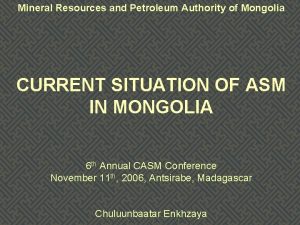Environment and Resources Deepsea mineral resources and environmental

- Slides: 1

Environment and Resources Deep-sea mineral resources and environmental management The United Nations International Seabed Authority (ISA) is responsible for managing mineral resources on the deep ocean seabed in areas beyond national jurisdiction. Minerals may occur in massive polymetallic sulphides on ocean ridges, cobalt rich ferromanganese crusts on seamounts and polymetallic nodules lying on abyssal sediments. Dr David Billett, Co-Chair of the Ocean Biogeochemistry and Ecosystems Group, NOCS, is a member of the UN ISA Legal and Technical Commission, charged with ensuring that deep-sea mineral resources are exploited within a robust environmental management plan. Mining in the deep-sea will have significant local impacts. Large areas of seafloor will be disturbed leading to the complete removal of fauna. It is therefore essential to know how quickly areas will be recolonised and over what scales biodiversity needs to maintained to allow seabed communities to recover. This requires knowledge of how species are distributed in different habitats in the deep ocean, their life processes, such as reproduction and dispersal, and the major drivers of species change in the deep sea. The drivers include sea surface primary productivity which fuels the vast majority of species in the oceans, even in the deepest parts. Research at NOCS is using molecular and experimental techniques to understand how widely, or not, species are distributed in the world ocean, how interconnected localised communities are, for instance on different seamounts, and how productivity leads to species change in space and time. International treaties are charged with deciding on how spatial planning of the ocean might allow the exploitation of resources and the conservation of biodiversity, including the creation of large Marine Protected Areas (MPAs). NOCS research is being used to decide how large the MPAs should be, what number, what shape and their configuration. The work is contributing to decisions being taken at the UN International Seabed Authority, the UN Convention on Biological Diversity, the Oslo-Paris Convention for the Protection of the Marine Environment in the NE Atlantic (OSPAR) and the European Commission. For further information: Dr David Billett Ocean Biogeochemistry and Ecosystems Group National Oceanography Centre, Southampton dsmb@noc. soton. ac. iuk www. southampton. ac. uk

